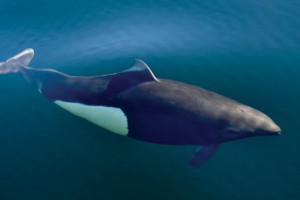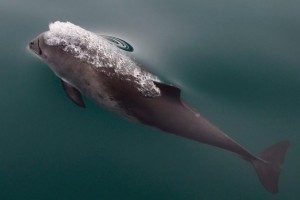 I imagine that the predominate species of Puget Sound whale or dolphin that comes to mind would be the charismatic orca. But there’s another group of marine mammals that people are perhaps a little less familiar with: porpoises. There are six species of true porpoises, and two of them can be seen in Puget Sound — the striking Dall’s porpoise and the less conspicuous harbor porpoise. The other species include the Burmeister’s porpoise (South America), the spectacled porpoise (Southern Ocean), the finless porpoise (Southeast Asia), and the highly endangered vaquita (Gulf of California — as of November 2016, it’s estimated there are only 30 individuals left in the wild).
I imagine that the predominate species of Puget Sound whale or dolphin that comes to mind would be the charismatic orca. But there’s another group of marine mammals that people are perhaps a little less familiar with: porpoises. There are six species of true porpoises, and two of them can be seen in Puget Sound — the striking Dall’s porpoise and the less conspicuous harbor porpoise. The other species include the Burmeister’s porpoise (South America), the spectacled porpoise (Southern Ocean), the finless porpoise (Southeast Asia), and the highly endangered vaquita (Gulf of California — as of November 2016, it’s estimated there are only 30 individuals left in the wild).
One may be inclined to say that whales are large and dolphins/porpoises are small, but this is not always true. Orcas are technically a dolphin, while a pygmy sperm whale (a member of the sperm whale family) only gets to 11 feet in length — about the same size as a bottlenose dolphin. Size, therefore, cannot be used to determine whether a cetacean is a whale, dolphin, or porpoise. One major difference between the three is their teeth, or in the case of baleen whales, their baleen. The two broadest categories of cetaceans are the two suborders Odontoceti (cetaceans that have teeth) or Mysteceti (cetaceans that have baleen). Baleen whales generally can also be identified by their two blowholes, as compared to the one blowhole of toothed whales. Toothed whales are divided into several more groups — the sperm whale family, dolphins, narwhals and belugas, and porpoises, as well as many others. While porpoises and dolphins are pretty similar, there are a couple of main differences. Dolphins have conical shaped teeth, while porpoises have spade shaped teeth. True porpoises also lack the “beak” that a dolphin has, and have a more triangular, shark-like dorsal fin compared to the curved dorsal fin of a dolphin.
The harbor porpoise has all of these characteristics — spade shaped teeth, rounded head, and a triangular dorsal fin. They are generally a uniform grey color and are on the very small side —from four and a half to six feet, and only get to about 120 pounds. To me, they look like a mini-version of a bottlenose dolphin without the beak, as if a bottlenose somehow lost its nose. Harbor porpoises are not gregarious like other species of dolphins and can be elusive. They are found in temperate waters in the northern hemisphere strictly along coastlines (hence the name “harbor” porpoise), and while dives over 600 feet deep have been recorded, they frequently stay near the surface and make frequent, shallow dives.
Dall’s porpoises are not much larger than a harbor porpoise — they grow up to seven feet long — but have a much more striking pattern of black and white, and also have a distinctive, stocky body shape. They are incredibly fast and can reach speeds of about 55 knots, making them the fastest porpoise. Dall’s porpoises are consistently seen traveling at high speeds out on the water, and their very triangular dorsal fin make a unique rooster tail pattern in the water when they are cruising. They are frequently observed more by sailors than the harbor porpoise. Dall’s porpoises can only be found in the North Pacific, though they do venture out past the coasts to the high seas.
Another fascinating difference between porpoises and dolphins that is in their ability to produce sounds. Dolphins are incredibly talkative and communicate with each other regularly through whistles and clicks. Porpoises are physiologically different in this regard, and so may be unable to produce the same range of noise that dolphins do. This difference may also provide an explanation for why they are so quiet in comparison.
 You may be surprised to know that even with all of these qualifications for telling a porpoise from a whale from a dolphin, sometimes the delineation between species is rather fluid. In general, different species don’t (or can’t) reproduce with one another, but sometimes there is evidence that two different species are interbreeding. These cases are known as hybridization, and have been observed in captivity amongst cetaceans, such as at the Sea Life Park in Hawaii with their “wholphin” Keikaimalu (her father was a false killer whale and her mother was a bottlenose dolphin). A significant case of hybridization in the wild was of a fetus recovered from a dead Dall’s porpoise that shared traits and genetics with harbor porpoises. Uniquely patterned porpoises have been observed in the North Pacific, and it’s a possibility that these observations were of these harbor porpoise/Dall’s porpoise hybrids.
You may be surprised to know that even with all of these qualifications for telling a porpoise from a whale from a dolphin, sometimes the delineation between species is rather fluid. In general, different species don’t (or can’t) reproduce with one another, but sometimes there is evidence that two different species are interbreeding. These cases are known as hybridization, and have been observed in captivity amongst cetaceans, such as at the Sea Life Park in Hawaii with their “wholphin” Keikaimalu (her father was a false killer whale and her mother was a bottlenose dolphin). A significant case of hybridization in the wild was of a fetus recovered from a dead Dall’s porpoise that shared traits and genetics with harbor porpoises. Uniquely patterned porpoises have been observed in the North Pacific, and it’s a possibility that these observations were of these harbor porpoise/Dall’s porpoise hybrids.
Next time you are out on the water, as well as looking for orcas, spare a glance for these porpoises. Whether you see a harbor porpoise, a Dall’s porpoise, or possibly even a hybrid, consider yourself very lucky to be on Pacific Northwest waters!
Photos by Simon Hook.